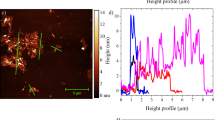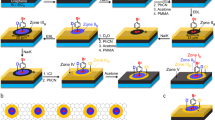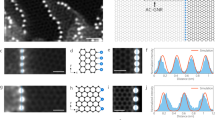Abstract
Atomic-scale defects in graphene layers alter the physical and chemical properties of carbon nanostructures1,2. Theoretical predictions have recently shown that energetic particles such as electrons and ions can induce polymorphic atomic defects in graphene layers as a result of knock-on atom displacements3,4. However, the number of experimental reports on these defects is limited5,6. The graphite network in single-walled carbon nanotubes has been visualized by transmission electron microscopy (TEM) and their chiral indices have been determined7,8. But the methods used require a long image acquisition time and intensive numerical treatments after observations to find an ‘average’ image, which prevents the accurate detection and investigation of defect structures. Here we report observations in situ of defect formation in single graphene layers by high-resolution TEM. The observed structures are expected to be of use when engineering the properties of carbon nanostructures for specific device applications.
This is a preview of subscription content, access via your institution
Access options
Subscribe to this journal
Receive 51 print issues and online access
$199.00 per year
only $3.90 per issue
Buy this article
- Purchase on Springer Link
- Instant access to full article PDF
Prices may be subject to local taxes which are calculated during checkout




Similar content being viewed by others
References
Hansson, A., Paulsson, M. & Stafström, S. Effect of bending and vacancies on the conductance of carbon nanotubes. Phys. Rev. B 62, 7639–7644 (2000)
Ewels, C. P., Heggie, M. I. & Briddon, P. R. Adatoms and nanoengineering of carbon. Chem. Phys. Lett. 351, 178–182 (2002)
Nordlund, K., Keinonen, J. & Mattila, T. Formation of ion irradiation induced small-scale defects on graphite surfaces. Phys. Rev. Lett. 77, 699–702 (1996)
Krasheninnikov, A. V., Nordlund, K., Sirviö, M., Salonen, E. & Keinonen, J. Formation of ion-irradiation-induced atomic-scale defects on walls of carbon nanotubes. Phys. Rev. B 63, 245405 (2001)
Kelly, K. F. & Halas, N. J. Determination of α and β site defects on graphite using C60-adsorbed STM tips. Surf. Sci. 416, L1085–L1089 (1998)
Ouyang, M., Huang, J.-L., Cheung, C. L. & Lieber, C. M. Atomically resolved single-walled carbon nanotube intramolecular junctions. Science 291, 97–100 (2001)
Meyer, R. R. et al. A composite method for the determination of the chirality of single walled carbon nanotube. J. Microsc. 212, 152–157 (2003)
Zuo, J. M., Vartanyants, I., Gao, M., Zhang, R. & Nagahara, L. A. Atomic resolution imaging of a carbon nanotube from diffraction intensities. Science 300, 1419–1421 (2003)
Stone, A. J. & Wales, D. J. Theoretical studies of icosahedral C60 and some related species. Chem. Phys. Lett. 128, 501–503 (1986)
Telling, R. H., Ewels, C. P., El-Barbary, A. A. & Heggie, M. I. Wigner defects bridge the graphite gap. Nature Mater. 2, 333–337 (2003)
El-Barbary, A. A., Telling, R. H., Ewels, C. P., Heggie, M. I. & Briddon, P. R. Structure and energetics of the vacancy in graphite. Phys. Rev. B 68, 144107 (2003)
Krasheninnikov, A. V. et al. Adsorption and migration of carbon adatoms on carbon nanotubes: Density-functional ab initio and tight-binding studies. Phys. Rev. B 69, 073402 (2004)
Ewels, C. P., Telling, R. H., El-Barbary, A. A., Heggie, M. I. & Briddon, P. R. Metastable Frenkel pair defect in graphite: Source of Wigner energy? Phys. Rev. Lett. 91, 25505 (2003)
Lehtinen, P. O. et al. Magnetic properties and diffusion of adatoms on a graphene sheet. Phys. Rev. Lett. 91, 17202 (2003)
Kociak, M., Hirahara, K., Suenaga, K. & Iijima, S. How accurate can the determination of chiral indices of carbon nanotubes be? Eur. Phys. J. B 32, 457–469 (2003)
Ajayan, P. M., Ravikumar, V. & Charlier, J.-C. Surface reconstructions and dimensional changes in single-walled carbon nanotubes. Phys. Rev. Lett. 81, 1437–1440 (1998)
Smith, B. W. & Luzzi, D. E. Electron irradiation effects in single wall carbon nanotubes. J. Appl. Phys. 90, 3509–3515 (2001)
Iijima, S. et al. Nano-aggregates of single-walled graphitic carbon nano-horns. Chem. Phys. Lett. 309, 165–170 (1999)
Yakobson, B. I., Samsonidze, G. & Samsonidze, G. G. Atomistic theory of mechanical relaxation in fullerene nanotubes. Carbon 38, 1675–1680 (2000)
Banhart, F. Irradiation effects in carbon nanostructures. Rep. Prog. Phys. 62, 1181–1221 (1999)
Hahn, J. R., Kang, H., Song, S. & Jeon, I. C. Observation of charge enhancement induced by graphite atomic vacancy: A comparative STM and AFM study. Phys. Rev. B 53, R1725–R1728 (1996)
Orlikowski, D., Buongiorno Nardelli, M., Bernholc, J. & Roland, C. Theoretical STM signatures and transport properties of native defects in carbon nanotubes. Phys. Rev. B 61, 14194–14203 (2000)
Asari, E., Kitajima, M., Nakamura, K. G. & Kawabe, T. Thermal relaxation of ion-irradiation damage in graphite. Phys. Rev. B 47, 11143–11148 (1993)
Hjort, M. & Stafström, S. Modeling vacancies in graphite via the Hückel method. Phys. Rev. B 61, 14089–14094 (2000)
Krasheninnikov, A. V., Nordlund, K. & Keinonen, J. Production of defects in supported carbon nanotubes under ion irradiation. Phys. Rev. B 65, 165423 (2002)
Lu, A. J. & Pan, B. C. Nature of single vacancy in achiral carbon nanotubes. Phys. Rev. Lett. 92, 105504 (2004)
Wildöer, J. W. G., Venema, L. C., Rinzler, A. G., Smalley, R. E. & Dekker, C. Electronic structure of atomically resolved carbon nanotubes. Nature 391, 59–62 (1998)
Odom, T. W., Huang, J.-L., Kim, P. & Lieber, C. M. Atomic structure and electronic properties of single-walled carbon nanotubes. Nature 391, 62–64 (1998)
Kociak, M. et al. Linking chiral indices and transport properties of double-walled carbon nanotubes. Phys. Rev. Lett. 81, 155501 (2002)
Acknowledgements
We thank M. Kociak for his instructions on the chiral index determination of SWNTs; C. Ewels and Y. Miyamoto for discussions on defective carbon structures; and M. Yudasaka and S. Bandow for help with specimen preparation. Work on HR-TEM is supported by the NEDO Nano-Carbon Technology project. A.H. was supported by Research Fellowships of the Japan Society for the Promotion of Science for Young Scientists.
Author information
Authors and Affiliations
Corresponding author
Ethics declarations
Competing interests
The authors declare that they have no competing financial interests.
Supplementary information
Supplementary Information Fig.S1 - S3
Fig.S1: Contrast transfer function chosen to enhance contrast made of the zig-zag chain (bottom inset) and a taken HR-TEM image of a SWNT; Fig.S2: A fast Fourier transform of the presented HR-TEM image of a graphene layer for the defocus value confirmation; Fig.S3: Relationship between the true diameter and the apparent diameter. (DOC 504 kb)
Supplementary Movie 1
A sequential HR-TEM images of the vacancy formation. See Fig. 3 and its captions. The bright spots correspond to the vacancies. (GIF 733 kb)
Supplementary Movie 2
A sequential HR-TEM images of the vacancy and adatom formation on a SWNT. One can see the bright spots as the vacancies. The dark spots moving around correspond to the carbon adatoms. See Fig. 4 and its captions. (GIF 671 kb)
Supplementary Movie 3
Another sequential HR-TEM images of the vacancy and adatom formation. (GIF 1244 kb)
Supplementary Movie 4
A sequential HR-TEM images presenting the formation of adatom/di-vacancy combination before collapse. See Fig. 4b, 4c and 4d. (GIF 187 kb)
Rights and permissions
About this article
Cite this article
Hashimoto, A., Suenaga, K., Gloter, A. et al. Direct evidence for atomic defects in graphene layers. Nature 430, 870–873 (2004). https://doi.org/10.1038/nature02817
Received:
Accepted:
Issue Date:
DOI: https://doi.org/10.1038/nature02817
This article is cited by
-
The Role of Graphene Defects in Graphene-Coated Copper Oxidation Behavior
Transactions of the Indian Institute of Metals (2024)
-
Substrate screening for superclean graphene growth using first-principles calculations
Nano Research (2024)
-
Radial-tangential mode of single-wall carbon nanotubes manifested by Landau regulation: reinterpretation of low- and intermediate-frequency Raman signals
Scientific Reports (2023)
-
Magnetic properties and critical behavior of quasi-2D layered Cr4Te5 thin film
Frontiers of Physics (2023)
-
Understanding and prediction of metastable single-layer metallene oxides
Science China Materials (2023)
Comments
By submitting a comment you agree to abide by our Terms and Community Guidelines. If you find something abusive or that does not comply with our terms or guidelines please flag it as inappropriate.



